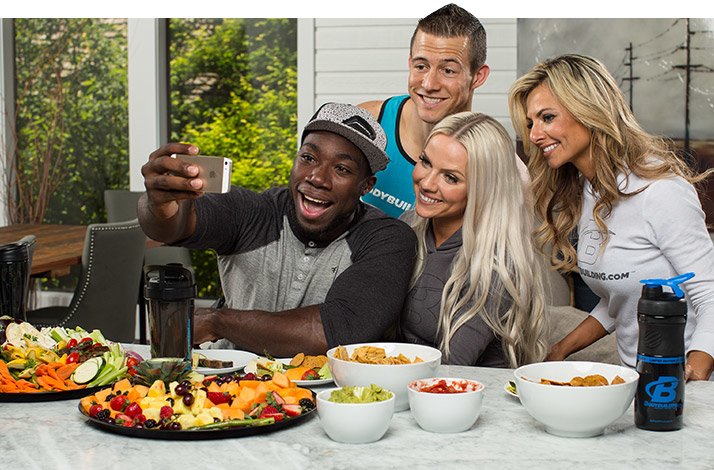
How To Take The Perfect Selfie
Laugh all you want, you know you want to cultivate better-looking self-portraits.
It's one of the most divisive words recently instated in the English dictionary. I've no doubt you've heard it before:
selfie \'sel-fe\ noun: An image of oneself taken by oneself using a digital camera especially for posting on social networks.
Hey, I saw that eye-roll just now, but here's the sitch: Selfies can actually be a great tool to keep track of your visual progress, even if you're not going to share them with the world.
Think about it: If every few weeks, you're taking pictures in the locker room, in front of your bathroom mirror, or wherever, you are quite literally creating a photo time-lapse of your day-to-day life and fitness journey. That's important because when your initial rah-rah fitness attitude begins to fade because you've hit a bump, or you're feeling unmotivated, you can look back at your older selfies to remind yourself why you started this and how far you've come. Oftentimes, this effectively reframes your mindset and pulls you right back out of your unmotivated slump.

It's powerful stuff, to be sure, but you first have to take the right selfies—not the kind to only garner likes on Instagram (although that's definitely a plus). While many folks are fine with just snapping and posting a blurry-whatever selfie, you, my friend, deserve far more than murky mediocrity.
Here's how you can take the perfect selfies—for Instagram, your own sake, or both!
Lighting Is Everything
A good photo hinges almost entirely on lighting—its availability, your position and direction you face in relation to the light source, and even whether the source comes from sunlight (through windows, for example) or artificial lighting. Every one of these lighting variables can influence the quality of the picture.
Many of us here at Bodybuilding.com are fans of natural lighting because it tends to add a nice vibrancy to your visage. So try to face the natural lighting source at various angles to avoid large amounts of shadows. Avoid direct fluorescent lights overhead. They seem to specifically be designed to make your selfie look like a campfire horror-story-telling session.
Definitely play around with standing in different parts of the room, preferably by a window. If you're hardcore, bring in your own additional light source to offset shadows. Whenever possible, avoid the overly yellowish hue that many artificial light fixtures can cast. Plus, with the right manipulation of light and shadow, you can bring greater emphasis to the chiseled muscles you've been working so hard on for the past few months.
"Facing light head-on can often make you look flat [appear less muscular than your potential]," warns Bodybuilding.com interactive editor Zeljan Avdic.
When working with less-than-desirable lighting conditions, you can still salvage mediocre selfies with editing tools. (More on that below!).
Find The Perfect Angle
Besides lighting, the angle of the selfie is perhaps the next biggest influencer. A great example of using angles to manipulate a look: the infamous "MySpace angle," coined for folks who held the photo-taking device overhead and took downward-facing shots, usually by their bathroom mirror.
The MySpace angle tends to make the subject "more flattering" and portrays a sense of coyness and illusion of leanness. If you're taking progress photos or want to be taken seriously, skip both dramatic MySpace and upward angles. Instead, aim to take the photo straight on or at different angles that emphasize what you want to show off.
For progress photos, head-on, direct shots (from the front, back, and sides) are best. You want to get the most honest portrayal of your body each and every time, anyway.
Choose An Interesting Background
I don't mean advertising your history of tightrope-walking while juggling knives. An interesting background, like the Empire State Building or on top of a mountain.
Outside of gym and locker-room photos, selfies and other "swole-fies" are best complemented by an interesting backdrop. You may argue that in some cases, these are no longer considered selfies, but you know what? A selfie taken with a timer or an imaginary friend in a fancy setting is okay in my book...as long as you strike a cool pose.
Pose With Confidence Pose
It definitely takes time to get over taking your own selfies. Initially, you might find it awkward and your discomfort will show, especially through your pose and body language. At first, it can be difficult to decide what to do with your hands all the time! Should they fall limp by your sides, give a peace sign, or position themselves into a power pose? (Personally, the peace sign is my jam.)
The choice is yours, but the pose will add an extra dimension to your selfie and bring attention to certain body parts. Bodybuilding.com forum member mhilliard44 adds, "Get the perfect angle to accentuate the muscle group that you would like to show off." For example, if you place your hands on your hips, you are better able to emphasize your triceps and deltoids.
Try Using Selfie Sticks
When your T-rex-like arms just aren't quite long enough to snap a good selfie, you can count on mankind's latest and greatest technological marvel: the selfie stick.
This ingenious, adjustable attachment usually has a clamp to hold your phone or device steady, freeing your hand to take all sorts of creative selfies. You can adjust the length to add more distance between you and the camera, which allows you to take an expanded view of you and your backdrop. (And yes, there is an underwater selfie stick.)
If a selfie stick is too bothersome, you can check out this self-adhesive apparatus.
Take Advantage of the Camera's Built-In Photo-Taking Timer
When you have more control over your environment but not enough hands, plant your camera in one place using various methods to cleverly prop it upright or on a tripod. Then use the countdown timer to allow yourself some time to get in position for the incoming photo.
On the iPhone, the self-timer usually takes a burst of 10 photos, spanning over a couple seconds, and you'll be able to keep and discard appropriately.
Take Many, Many Photos
Good photographers know that even with an ideal vision, all the planning in the world, and the proper setup, sometimes you just can't capture exactly what you had in mind in one go. So, be sure to take multiple photos of the same shot. "Invest at least 30 minutes per selfie session. Preferably an hour," suggests Bodybuilding.com web editor Alex Mihailescu. This is serious business, folks.
Who knows, maybe due to the singular flap of a butterfly wing, a small, unplanned change in the conditions can dramatically impact the selfie and tip it in your favor. By having multiple options, you give yourself more control over the best portrayal for your image on social media—and really, that's why we're all really in this article, right? The rest that don't look up to snuff belong in the smoldering pits of a Texas barbecue hoedown.
For Progress Pictures, Keep Conditions the Same
In the case of taking progress photos, keep all the conditions the same to better and more accurately reflect your visual progress over time. That means consistently wearing the same clothes (though let's hope you at least wash them between pictures), and taking your progress photos at the same time of day with the same foods eaten prior (if possible), same lighting, same angle, and same background. You'd be surprised by how factors such as the types of food eaten and the time of day can drastically impact the results of your progress pictures.
In essence, if you want consistency, keep all these selfie variables static to focus on being able to capture all the changes happening to your body over time.
Use a Filter to Instantly Amaze
"Selfies are about 70 percent filters, 20 percent lighting, and 10 percent actual physical fitness," says Keith Sivera, Bodybuilding.com's director of offline marketing. Whether he made such a bold claim in jest or not, there's a certain element of truth to that.
Numerous filters automatically apply certain presets (e.g. brightness, shadows, contrast) and take out the extra editing work. Filters are designed to convey a certain attitude or look to the selfie. Filters with yellowish hues and intense contrast often give a sense of warmth and intensity and can be appropriate for action or playful shots. Conversely, blue tints can convey a sense of coolness and would be apt for more dramatic shots.
These aren't hard-and-fast rules. Post-production with filters is meant to be fun and encourage you to experiment. For good practice, be sure to go through all the filters to see which make your selfie pop out more.
Play With Photo-Editing Options
So your selfie did not exactly come out looking like a Scarlett Johansson modeling shot, but hey, that's why the ability to edit photos exists. Praise technology!
While some people can go the extra mile to pull up Photoshop or some similar fancy editing software, you can simply use Instagram's built-in editing options, or even other photo-editing apps, including Snapseed and Aviary, to name a few.

Play with a few options, although you may not necessarily know what they do initially:
- Brightness: Lightens and darkens the photo.
- Contrast: Adjusts the black and white balance. Makes dark spots darker and light spots lighter.
- Shadows/Highlights: These tend to go hand in hand, but have separate controls. Adjust each accordingly to potentially add more detail from shadows and highlights.
- Saturation: Increase or decrease the concentration of colored pixels in your picture.
Basically, just play with the slider until the picture looks about right to you. Once those five settings meet your satisfaction, feel free to play with other settings like tint, blur, vignette, and more. (Remember that on Instagram, you can tap and hold the picture to compare your current edits to the original so that you can see the differences you are applying.)
While editing photos can make a photo even more awesome, our graphic designer, Meghan Kahnle, notes that overdoing it with saturation, brightness, filters, and the like can turn an otherwise cool selfie into a pixilated, cartoon-y mess.
Above All, Be Yourself!
Whether you use the selfies to keep a record of your progress or to share on social media, they should show off your passion for this lifestyle we all love.
"I plan my training around the skills I want to keep developing: I warm up, hit a working set, then prop my phone against my shaker cup, and capture a set to share," says Kandace Hudspeth, Bodybuilding.com's vice president of marketing, of her own selfies and Instagram posts. "No fuss—just my everyday effort to be better than I was yesterday. You are in the gym to train; that should always remain your number one priority."
Did we miss any crucial tips? Share your selfie-taking tips with others in the comments below and show us your awesome selfies with the hashtag #transformforlife on Instagram, too!
